MWF30004: Analyzing Challenges to Midwifery Autonomy and its Impact
VerifiedAdded on 2023/06/04
|17
|4542
|172
Essay
AI Summary
This essay critically analyzes the challenges to midwifery autonomy based on a qualitative interview with a registered midwife. The main challenge identified is the impact of medicalization of birth, where the involvement of doctors, even in low-risk cases, affects midwives' autonomy and their ability to provide women-centered care. Key themes explored include the medicalization of childbirth, the power dynamics between midwives and doctors, and the impact of these factors on midwives' autonomy in the workplace. The essay also discusses sub-themes such as the fear of litigation, defensive medicine, fading midwifery skills, and the importance of women's choice. The analysis is supported by current midwifery literature, highlighting the debates around the concept of 'normality' in childbirth and the increasing medical interventions that limit midwives' autonomy and women's freedom of choice. The essay concludes by emphasizing the need for recognition of each other expertise to improve midwifery practice.
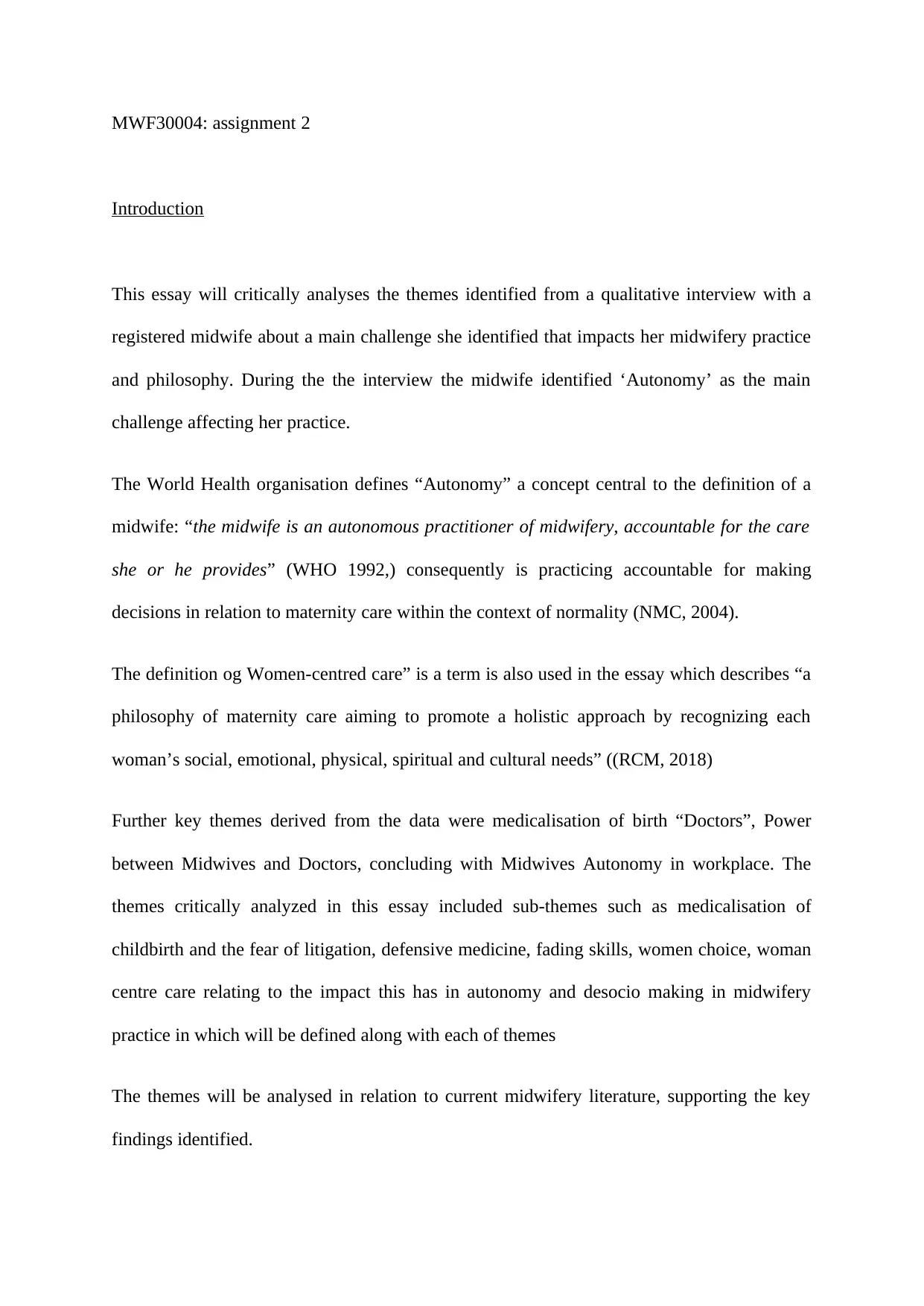
MWF30004: assignment 2
Introduction
This essay will critically analyses the themes identified from a qualitative interview with a
registered midwife about a main challenge she identified that impacts her midwifery practice
and philosophy. During the the interview the midwife identified ‘Autonomy’ as the main
challenge affecting her practice.
The World Health organisation defines “Autonomy” a concept central to the definition of a
midwife: “the midwife is an autonomous practitioner of midwifery, accountable for the care
she or he provides” (WHO 1992,) consequently is practicing accountable for making
decisions in relation to maternity care within the context of normality (NMC, 2004).
The definition og Women-centred care” is a term is also used in the essay which describes “a
philosophy of maternity care aiming to promote a holistic approach by recognizing each
woman’s social, emotional, physical, spiritual and cultural needs” ((RCM, 2018)
Further key themes derived from the data were medicalisation of birth “Doctors”, Power
between Midwives and Doctors, concluding with Midwives Autonomy in workplace. The
themes critically analyzed in this essay included sub-themes such as medicalisation of
childbirth and the fear of litigation, defensive medicine, fading skills, women choice, woman
centre care relating to the impact this has in autonomy and desocio making in midwifery
practice in which will be defined along with each of themes
The themes will be analysed in relation to current midwifery literature, supporting the key
findings identified.
Introduction
This essay will critically analyses the themes identified from a qualitative interview with a
registered midwife about a main challenge she identified that impacts her midwifery practice
and philosophy. During the the interview the midwife identified ‘Autonomy’ as the main
challenge affecting her practice.
The World Health organisation defines “Autonomy” a concept central to the definition of a
midwife: “the midwife is an autonomous practitioner of midwifery, accountable for the care
she or he provides” (WHO 1992,) consequently is practicing accountable for making
decisions in relation to maternity care within the context of normality (NMC, 2004).
The definition og Women-centred care” is a term is also used in the essay which describes “a
philosophy of maternity care aiming to promote a holistic approach by recognizing each
woman’s social, emotional, physical, spiritual and cultural needs” ((RCM, 2018)
Further key themes derived from the data were medicalisation of birth “Doctors”, Power
between Midwives and Doctors, concluding with Midwives Autonomy in workplace. The
themes critically analyzed in this essay included sub-themes such as medicalisation of
childbirth and the fear of litigation, defensive medicine, fading skills, women choice, woman
centre care relating to the impact this has in autonomy and desocio making in midwifery
practice in which will be defined along with each of themes
The themes will be analysed in relation to current midwifery literature, supporting the key
findings identified.
Paraphrase This Document
Need a fresh take? Get an instant paraphrase of this document with our AI Paraphraser
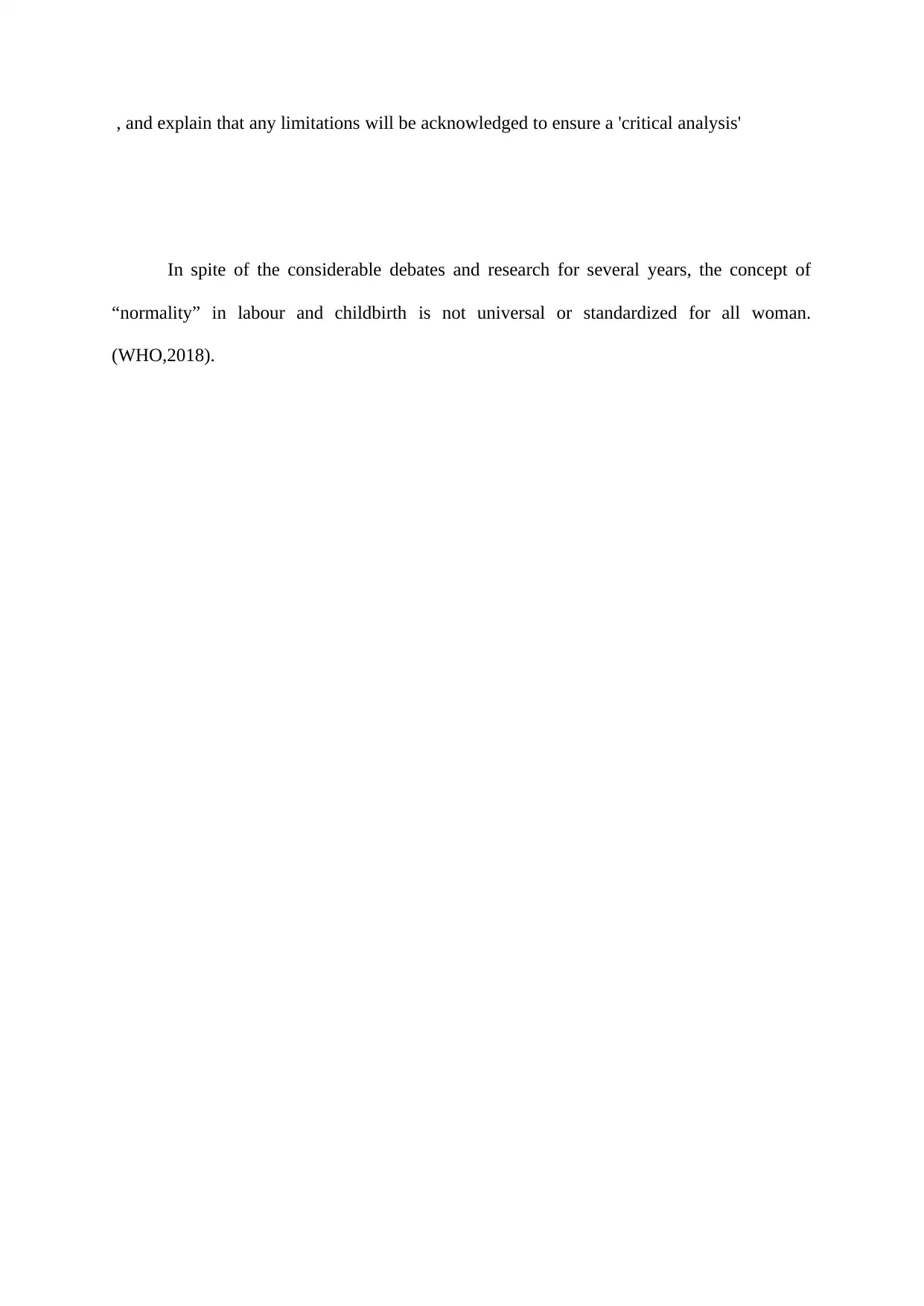
, and explain that any limitations will be acknowledged to ensure a 'critical analysis'
In spite of the considerable debates and research for several years, the concept of
“normality” in labour and childbirth is not universal or standardized for all woman.
(WHO,2018).
In spite of the considerable debates and research for several years, the concept of
“normality” in labour and childbirth is not universal or standardized for all woman.
(WHO,2018).
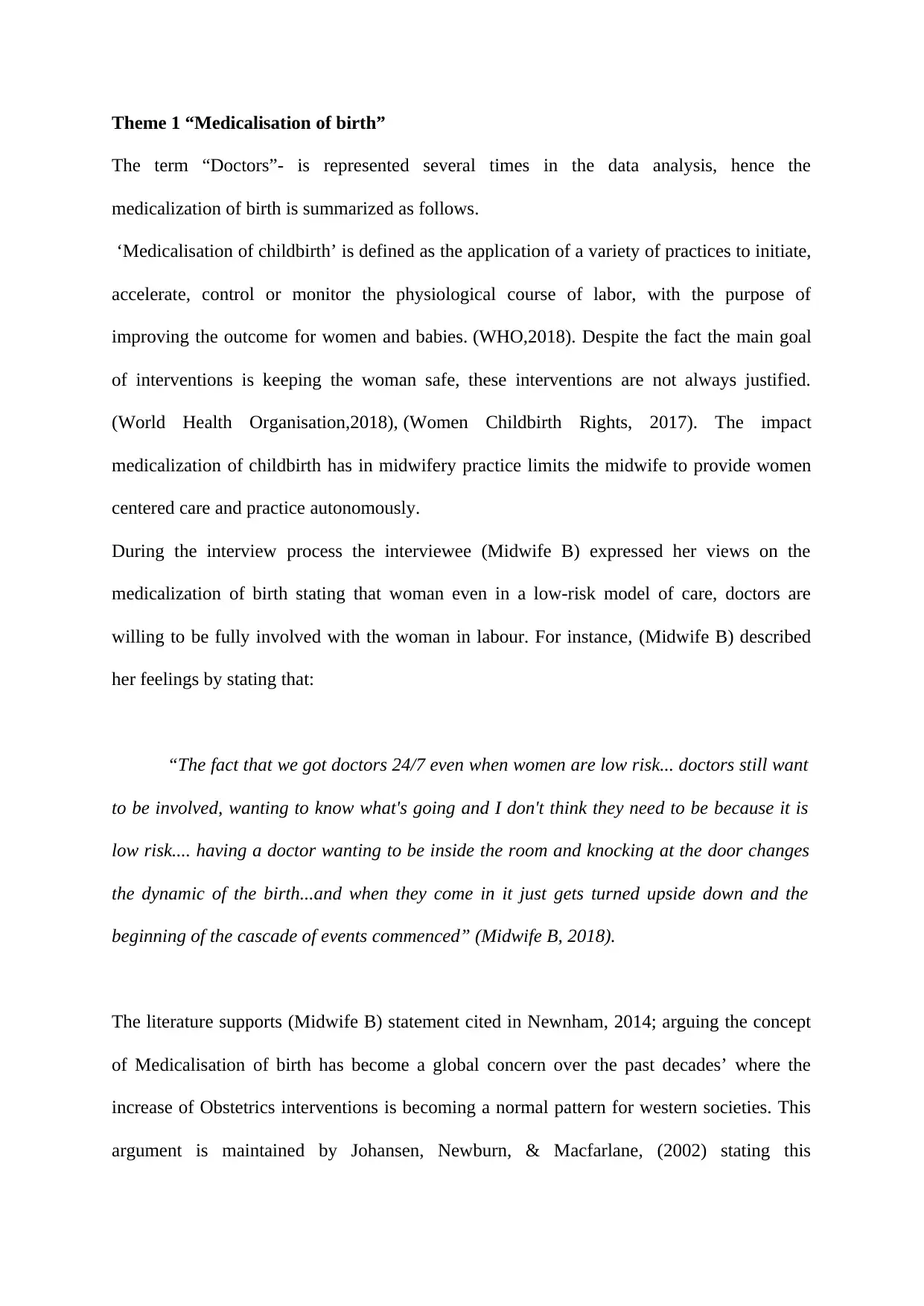
Theme 1 “Medicalisation of birth”
The term “Doctors”- is represented several times in the data analysis, hence the
medicalization of birth is summarized as follows.
‘Medicalisation of childbirth’ is defined as the application of a variety of practices to initiate,
accelerate, control or monitor the physiological course of labor, with the purpose of
improving the outcome for women and babies. (WHO,2018). Despite the fact the main goal
of interventions is keeping the woman safe, these interventions are not always justified.
(World Health Organisation,2018), (Women Childbirth Rights, 2017). The impact
medicalization of childbirth has in midwifery practice limits the midwife to provide women
centered care and practice autonomously.
During the interview process the interviewee (Midwife B) expressed her views on the
medicalization of birth stating that woman even in a low-risk model of care, doctors are
willing to be fully involved with the woman in labour. For instance, (Midwife B) described
her feelings by stating that:
“The fact that we got doctors 24/7 even when women are low risk... doctors still want
to be involved, wanting to know what's going and I don't think they need to be because it is
low risk.... having a doctor wanting to be inside the room and knocking at the door changes
the dynamic of the birth...and when they come in it just gets turned upside down and the
beginning of the cascade of events commenced” (Midwife B, 2018).
The literature supports (Midwife B) statement cited in Newnham, 2014; arguing the concept
of Medicalisation of birth has become a global concern over the past decades’ where the
increase of Obstetrics interventions is becoming a normal pattern for western societies. This
argument is maintained by Johansen, Newburn, & Macfarlane, (2002) stating this
The term “Doctors”- is represented several times in the data analysis, hence the
medicalization of birth is summarized as follows.
‘Medicalisation of childbirth’ is defined as the application of a variety of practices to initiate,
accelerate, control or monitor the physiological course of labor, with the purpose of
improving the outcome for women and babies. (WHO,2018). Despite the fact the main goal
of interventions is keeping the woman safe, these interventions are not always justified.
(World Health Organisation,2018), (Women Childbirth Rights, 2017). The impact
medicalization of childbirth has in midwifery practice limits the midwife to provide women
centered care and practice autonomously.
During the interview process the interviewee (Midwife B) expressed her views on the
medicalization of birth stating that woman even in a low-risk model of care, doctors are
willing to be fully involved with the woman in labour. For instance, (Midwife B) described
her feelings by stating that:
“The fact that we got doctors 24/7 even when women are low risk... doctors still want
to be involved, wanting to know what's going and I don't think they need to be because it is
low risk.... having a doctor wanting to be inside the room and knocking at the door changes
the dynamic of the birth...and when they come in it just gets turned upside down and the
beginning of the cascade of events commenced” (Midwife B, 2018).
The literature supports (Midwife B) statement cited in Newnham, 2014; arguing the concept
of Medicalisation of birth has become a global concern over the past decades’ where the
increase of Obstetrics interventions is becoming a normal pattern for western societies. This
argument is maintained by Johansen, Newburn, & Macfarlane, (2002) stating this
⊘ This is a preview!⊘
Do you want full access?
Subscribe today to unlock all pages.

Trusted by 1+ million students worldwide
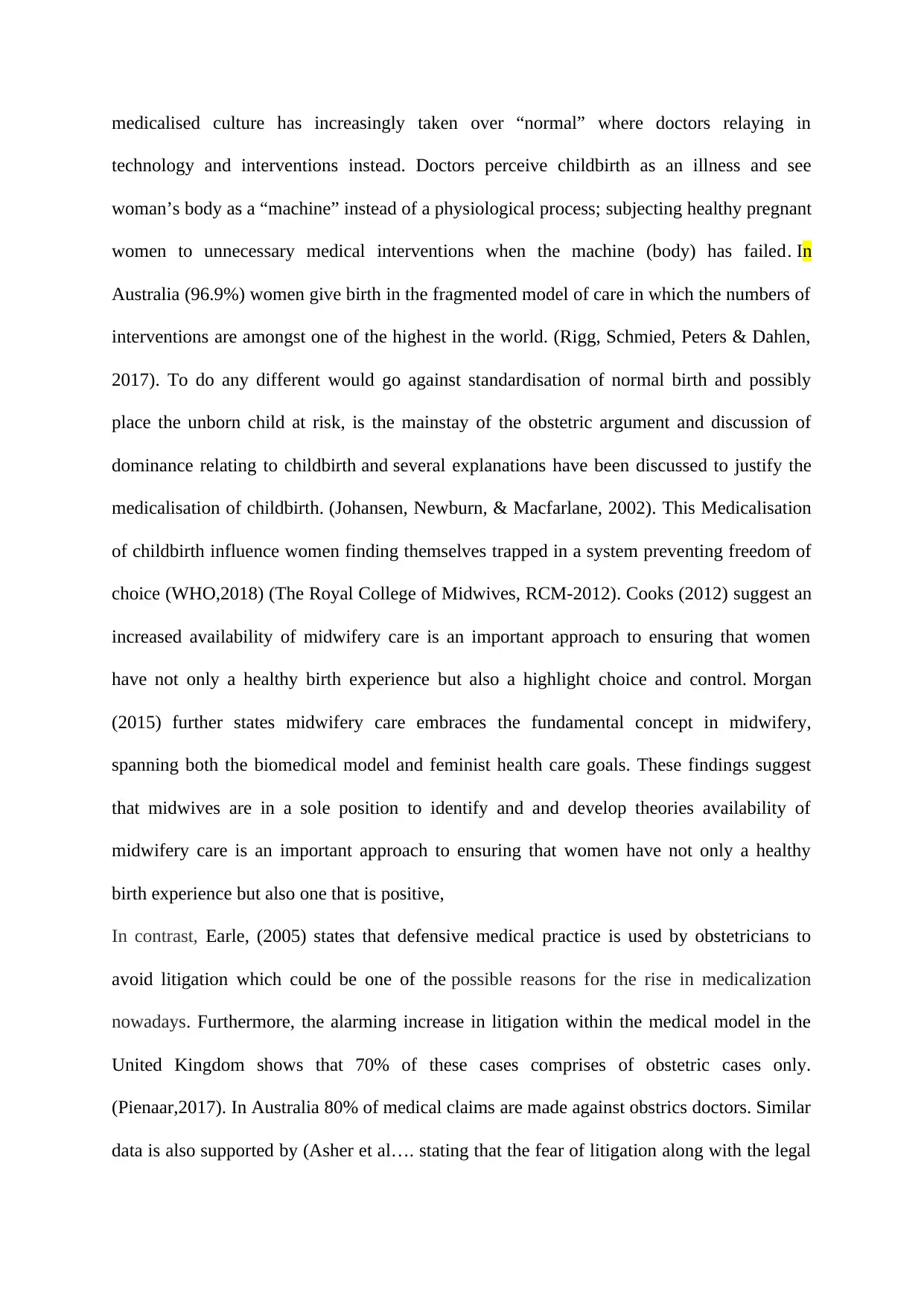
medicalised culture has increasingly taken over “normal” where doctors relaying in
technology and interventions instead. Doctors perceive childbirth as an illness and see
woman’s body as a “machine” instead of a physiological process; subjecting healthy pregnant
women to unnecessary medical interventions when the machine (body) has failed. In
Australia (96.9%) women give birth in the fragmented model of care in which the numbers of
interventions are amongst one of the highest in the world. (Rigg, Schmied, Peters & Dahlen,
2017). To do any different would go against standardisation of normal birth and possibly
place the unborn child at risk, is the mainstay of the obstetric argument and discussion of
dominance relating to childbirth and several explanations have been discussed to justify the
medicalisation of childbirth. (Johansen, Newburn, & Macfarlane, 2002). This Medicalisation
of childbirth influence women finding themselves trapped in a system preventing freedom of
choice (WHO,2018) (The Royal College of Midwives, RCM-2012). Cooks (2012) suggest an
increased availability of midwifery care is an important approach to ensuring that women
have not only a healthy birth experience but also a highlight choice and control. Morgan
(2015) further states midwifery care embraces the fundamental concept in midwifery,
spanning both the biomedical model and feminist health care goals. These findings suggest
that midwives are in a sole position to identify and and develop theories availability of
midwifery care is an important approach to ensuring that women have not only a healthy
birth experience but also one that is positive,
In contrast, Earle, (2005) states that defensive medical practice is used by obstetricians to
avoid litigation which could be one of the possible reasons for the rise in medicalization
nowadays. Furthermore, the alarming increase in litigation within the medical model in the
United Kingdom shows that 70% of these cases comprises of obstetric cases only.
(Pienaar,2017). In Australia 80% of medical claims are made against obstrics doctors. Similar
data is also supported by (Asher et al…. stating that the fear of litigation along with the legal
technology and interventions instead. Doctors perceive childbirth as an illness and see
woman’s body as a “machine” instead of a physiological process; subjecting healthy pregnant
women to unnecessary medical interventions when the machine (body) has failed. In
Australia (96.9%) women give birth in the fragmented model of care in which the numbers of
interventions are amongst one of the highest in the world. (Rigg, Schmied, Peters & Dahlen,
2017). To do any different would go against standardisation of normal birth and possibly
place the unborn child at risk, is the mainstay of the obstetric argument and discussion of
dominance relating to childbirth and several explanations have been discussed to justify the
medicalisation of childbirth. (Johansen, Newburn, & Macfarlane, 2002). This Medicalisation
of childbirth influence women finding themselves trapped in a system preventing freedom of
choice (WHO,2018) (The Royal College of Midwives, RCM-2012). Cooks (2012) suggest an
increased availability of midwifery care is an important approach to ensuring that women
have not only a healthy birth experience but also a highlight choice and control. Morgan
(2015) further states midwifery care embraces the fundamental concept in midwifery,
spanning both the biomedical model and feminist health care goals. These findings suggest
that midwives are in a sole position to identify and and develop theories availability of
midwifery care is an important approach to ensuring that women have not only a healthy
birth experience but also one that is positive,
In contrast, Earle, (2005) states that defensive medical practice is used by obstetricians to
avoid litigation which could be one of the possible reasons for the rise in medicalization
nowadays. Furthermore, the alarming increase in litigation within the medical model in the
United Kingdom shows that 70% of these cases comprises of obstetric cases only.
(Pienaar,2017). In Australia 80% of medical claims are made against obstrics doctors. Similar
data is also supported by (Asher et al…. stating that the fear of litigation along with the legal
Paraphrase This Document
Need a fresh take? Get an instant paraphrase of this document with our AI Paraphraser
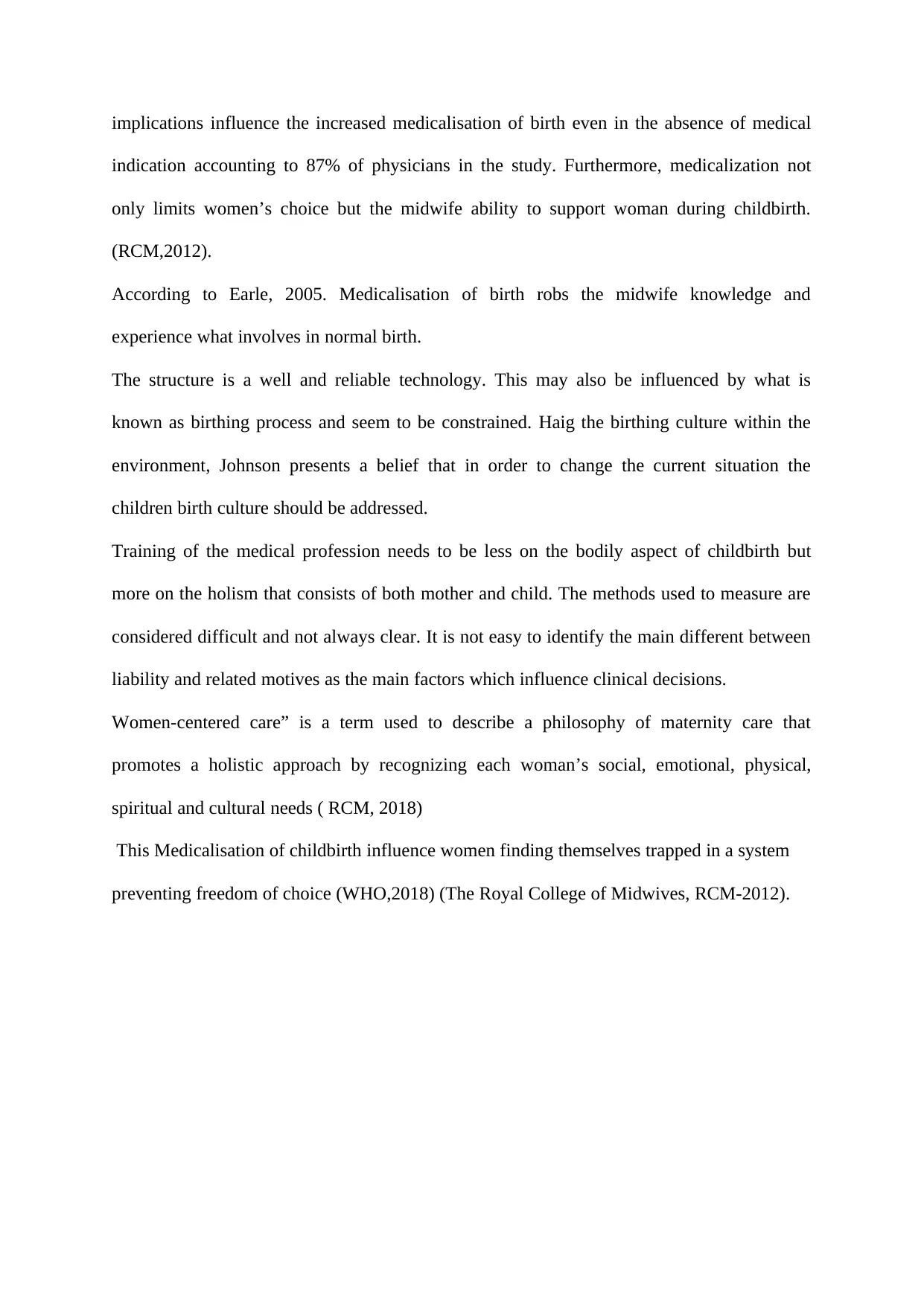
implications influence the increased medicalisation of birth even in the absence of medical
indication accounting to 87% of physicians in the study. Furthermore, medicalization not
only limits women’s choice but the midwife ability to support woman during childbirth.
(RCM,2012).
According to Earle, 2005. Medicalisation of birth robs the midwife knowledge and
experience what involves in normal birth.
The structure is a well and reliable technology. This may also be influenced by what is
known as birthing process and seem to be constrained. Haig the birthing culture within the
environment, Johnson presents a belief that in order to change the current situation the
children birth culture should be addressed.
Training of the medical profession needs to be less on the bodily aspect of childbirth but
more on the holism that consists of both mother and child. The methods used to measure are
considered difficult and not always clear. It is not easy to identify the main different between
liability and related motives as the main factors which influence clinical decisions.
Women-centered care” is a term used to describe a philosophy of maternity care that
promotes a holistic approach by recognizing each woman’s social, emotional, physical,
spiritual and cultural needs ( RCM, 2018)
This Medicalisation of childbirth influence women finding themselves trapped in a system
preventing freedom of choice (WHO,2018) (The Royal College of Midwives, RCM-2012).
indication accounting to 87% of physicians in the study. Furthermore, medicalization not
only limits women’s choice but the midwife ability to support woman during childbirth.
(RCM,2012).
According to Earle, 2005. Medicalisation of birth robs the midwife knowledge and
experience what involves in normal birth.
The structure is a well and reliable technology. This may also be influenced by what is
known as birthing process and seem to be constrained. Haig the birthing culture within the
environment, Johnson presents a belief that in order to change the current situation the
children birth culture should be addressed.
Training of the medical profession needs to be less on the bodily aspect of childbirth but
more on the holism that consists of both mother and child. The methods used to measure are
considered difficult and not always clear. It is not easy to identify the main different between
liability and related motives as the main factors which influence clinical decisions.
Women-centered care” is a term used to describe a philosophy of maternity care that
promotes a holistic approach by recognizing each woman’s social, emotional, physical,
spiritual and cultural needs ( RCM, 2018)
This Medicalisation of childbirth influence women finding themselves trapped in a system
preventing freedom of choice (WHO,2018) (The Royal College of Midwives, RCM-2012).
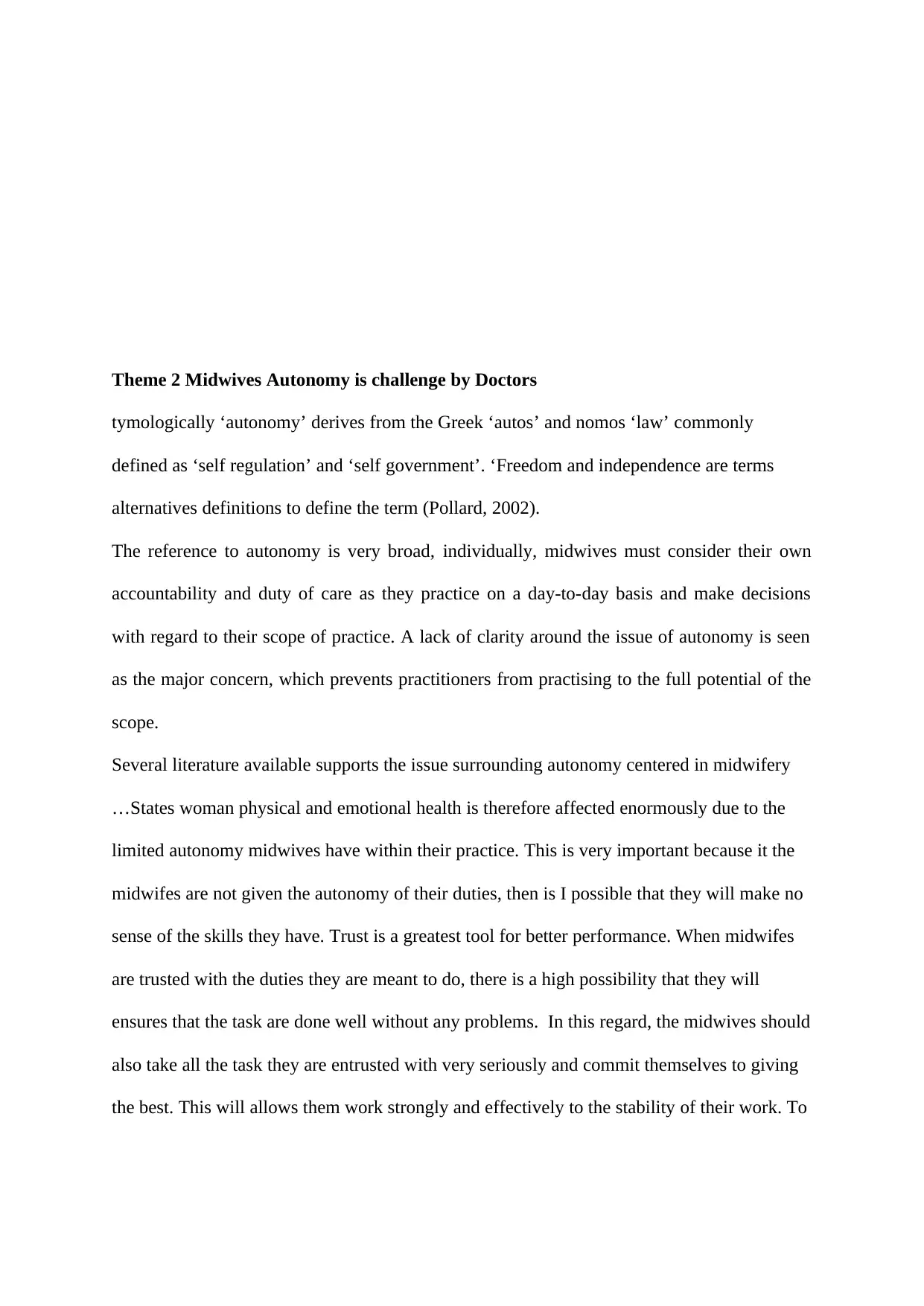
Theme 2 Midwives Autonomy is challenge by Doctors
tymologically ‘autonomy’ derives from the Greek ‘autos’ and nomos ‘law’ commonly
defined as ‘self regulation’ and ‘self government’. ‘Freedom and independence are terms
alternatives definitions to define the term (Pollard, 2002).
The reference to autonomy is very broad, individually, midwives must consider their own
accountability and duty of care as they practice on a day-to-day basis and make decisions
with regard to their scope of practice. A lack of clarity around the issue of autonomy is seen
as the major concern, which prevents practitioners from practising to the full potential of the
scope.
Several literature available supports the issue surrounding autonomy centered in midwifery
…States woman physical and emotional health is therefore affected enormously due to the
limited autonomy midwives have within their practice. This is very important because it the
midwifes are not given the autonomy of their duties, then is I possible that they will make no
sense of the skills they have. Trust is a greatest tool for better performance. When midwifes
are trusted with the duties they are meant to do, there is a high possibility that they will
ensures that the task are done well without any problems. In this regard, the midwives should
also take all the task they are entrusted with very seriously and commit themselves to giving
the best. This will allows them work strongly and effectively to the stability of their work. To
tymologically ‘autonomy’ derives from the Greek ‘autos’ and nomos ‘law’ commonly
defined as ‘self regulation’ and ‘self government’. ‘Freedom and independence are terms
alternatives definitions to define the term (Pollard, 2002).
The reference to autonomy is very broad, individually, midwives must consider their own
accountability and duty of care as they practice on a day-to-day basis and make decisions
with regard to their scope of practice. A lack of clarity around the issue of autonomy is seen
as the major concern, which prevents practitioners from practising to the full potential of the
scope.
Several literature available supports the issue surrounding autonomy centered in midwifery
…States woman physical and emotional health is therefore affected enormously due to the
limited autonomy midwives have within their practice. This is very important because it the
midwifes are not given the autonomy of their duties, then is I possible that they will make no
sense of the skills they have. Trust is a greatest tool for better performance. When midwifes
are trusted with the duties they are meant to do, there is a high possibility that they will
ensures that the task are done well without any problems. In this regard, the midwives should
also take all the task they are entrusted with very seriously and commit themselves to giving
the best. This will allows them work strongly and effectively to the stability of their work. To
⊘ This is a preview!⊘
Do you want full access?
Subscribe today to unlock all pages.

Trusted by 1+ million students worldwide
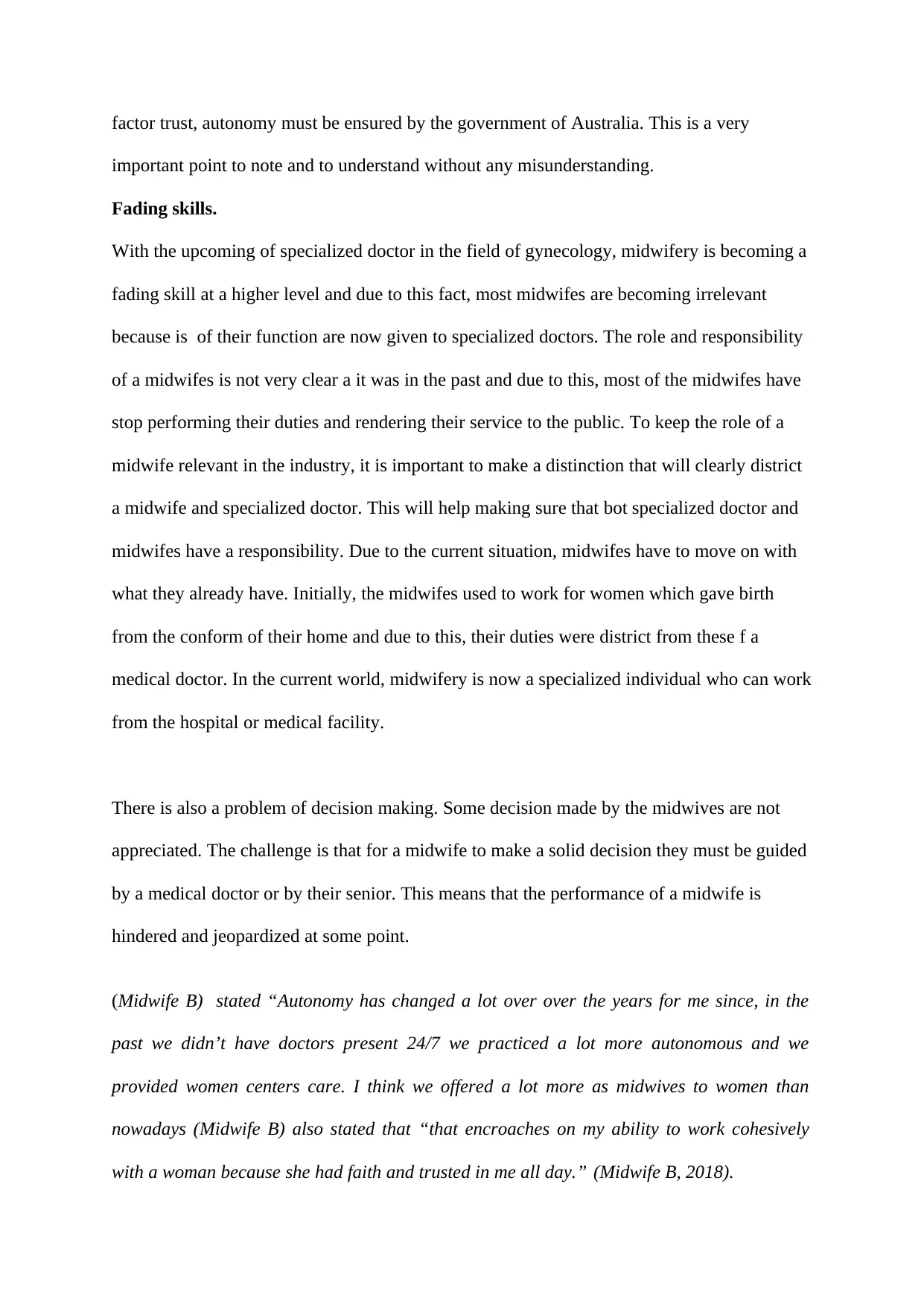
factor trust, autonomy must be ensured by the government of Australia. This is a very
important point to note and to understand without any misunderstanding.
Fading skills.
With the upcoming of specialized doctor in the field of gynecology, midwifery is becoming a
fading skill at a higher level and due to this fact, most midwifes are becoming irrelevant
because is of their function are now given to specialized doctors. The role and responsibility
of a midwifes is not very clear a it was in the past and due to this, most of the midwifes have
stop performing their duties and rendering their service to the public. To keep the role of a
midwife relevant in the industry, it is important to make a distinction that will clearly district
a midwife and specialized doctor. This will help making sure that bot specialized doctor and
midwifes have a responsibility. Due to the current situation, midwifes have to move on with
what they already have. Initially, the midwifes used to work for women which gave birth
from the conform of their home and due to this, their duties were district from these f a
medical doctor. In the current world, midwifery is now a specialized individual who can work
from the hospital or medical facility.
There is also a problem of decision making. Some decision made by the midwives are not
appreciated. The challenge is that for a midwife to make a solid decision they must be guided
by a medical doctor or by their senior. This means that the performance of a midwife is
hindered and jeopardized at some point.
(Midwife B) stated “Autonomy has changed a lot over over the years for me since, in the
past we didn’t have doctors present 24/7 we practiced a lot more autonomous and we
provided women centers care. I think we offered a lot more as midwives to women than
nowadays (Midwife B) also stated that “that encroaches on my ability to work cohesively
with a woman because she had faith and trusted in me all day.” (Midwife B, 2018).
important point to note and to understand without any misunderstanding.
Fading skills.
With the upcoming of specialized doctor in the field of gynecology, midwifery is becoming a
fading skill at a higher level and due to this fact, most midwifes are becoming irrelevant
because is of their function are now given to specialized doctors. The role and responsibility
of a midwifes is not very clear a it was in the past and due to this, most of the midwifes have
stop performing their duties and rendering their service to the public. To keep the role of a
midwife relevant in the industry, it is important to make a distinction that will clearly district
a midwife and specialized doctor. This will help making sure that bot specialized doctor and
midwifes have a responsibility. Due to the current situation, midwifes have to move on with
what they already have. Initially, the midwifes used to work for women which gave birth
from the conform of their home and due to this, their duties were district from these f a
medical doctor. In the current world, midwifery is now a specialized individual who can work
from the hospital or medical facility.
There is also a problem of decision making. Some decision made by the midwives are not
appreciated. The challenge is that for a midwife to make a solid decision they must be guided
by a medical doctor or by their senior. This means that the performance of a midwife is
hindered and jeopardized at some point.
(Midwife B) stated “Autonomy has changed a lot over over the years for me since, in the
past we didn’t have doctors present 24/7 we practiced a lot more autonomous and we
provided women centers care. I think we offered a lot more as midwives to women than
nowadays (Midwife B) also stated that “that encroaches on my ability to work cohesively
with a woman because she had faith and trusted in me all day.” (Midwife B, 2018).
Paraphrase This Document
Need a fresh take? Get an instant paraphrase of this document with our AI Paraphraser
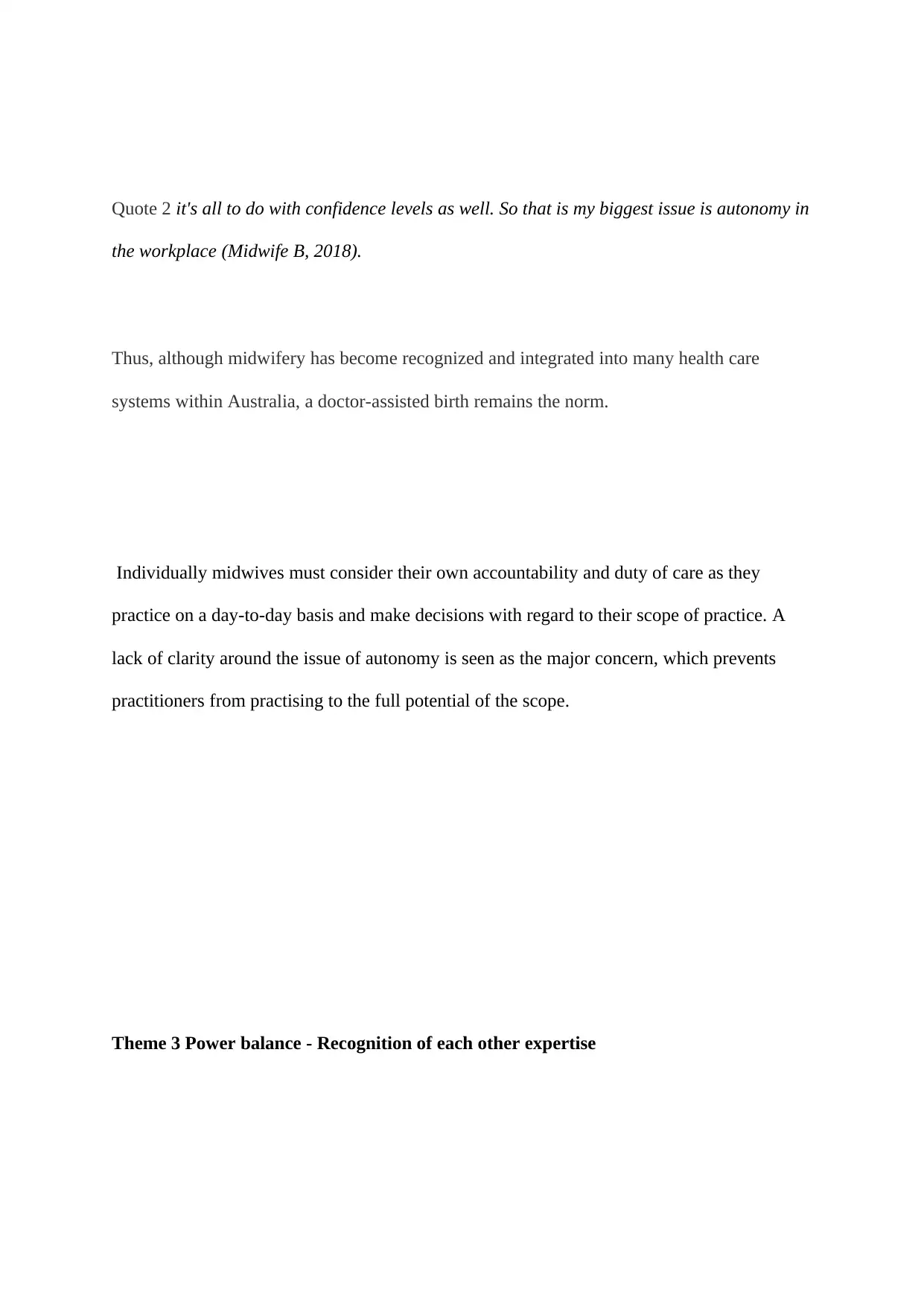
Quote 2 it's all to do with confidence levels as well. So that is my biggest issue is autonomy in
the workplace (Midwife B, 2018).
Thus, although midwifery has become recognized and integrated into many health care
systems within Australia, a doctor-assisted birth remains the norm.
Individually midwives must consider their own accountability and duty of care as they
practice on a day-to-day basis and make decisions with regard to their scope of practice. A
lack of clarity around the issue of autonomy is seen as the major concern, which prevents
practitioners from practising to the full potential of the scope.
Theme 3 Power balance - Recognition of each other expertise
the workplace (Midwife B, 2018).
Thus, although midwifery has become recognized and integrated into many health care
systems within Australia, a doctor-assisted birth remains the norm.
Individually midwives must consider their own accountability and duty of care as they
practice on a day-to-day basis and make decisions with regard to their scope of practice. A
lack of clarity around the issue of autonomy is seen as the major concern, which prevents
practitioners from practising to the full potential of the scope.
Theme 3 Power balance - Recognition of each other expertise
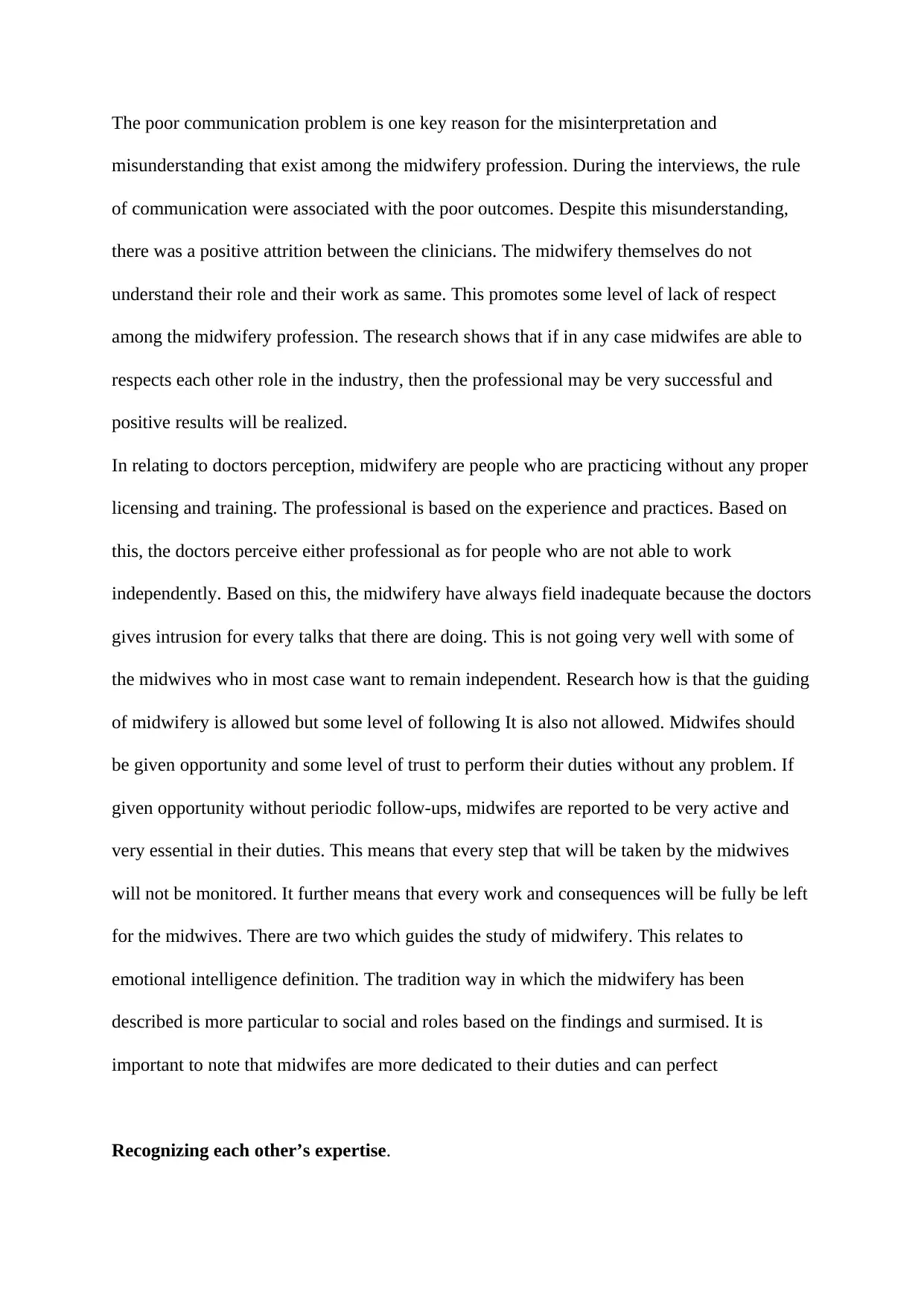
The poor communication problem is one key reason for the misinterpretation and
misunderstanding that exist among the midwifery profession. During the interviews, the rule
of communication were associated with the poor outcomes. Despite this misunderstanding,
there was a positive attrition between the clinicians. The midwifery themselves do not
understand their role and their work as same. This promotes some level of lack of respect
among the midwifery profession. The research shows that if in any case midwifes are able to
respects each other role in the industry, then the professional may be very successful and
positive results will be realized.
In relating to doctors perception, midwifery are people who are practicing without any proper
licensing and training. The professional is based on the experience and practices. Based on
this, the doctors perceive either professional as for people who are not able to work
independently. Based on this, the midwifery have always field inadequate because the doctors
gives intrusion for every talks that there are doing. This is not going very well with some of
the midwives who in most case want to remain independent. Research how is that the guiding
of midwifery is allowed but some level of following It is also not allowed. Midwifes should
be given opportunity and some level of trust to perform their duties without any problem. If
given opportunity without periodic follow-ups, midwifes are reported to be very active and
very essential in their duties. This means that every step that will be taken by the midwives
will not be monitored. It further means that every work and consequences will be fully be left
for the midwives. There are two which guides the study of midwifery. This relates to
emotional intelligence definition. The tradition way in which the midwifery has been
described is more particular to social and roles based on the findings and surmised. It is
important to note that midwifes are more dedicated to their duties and can perfect
Recognizing each other’s expertise.
misunderstanding that exist among the midwifery profession. During the interviews, the rule
of communication were associated with the poor outcomes. Despite this misunderstanding,
there was a positive attrition between the clinicians. The midwifery themselves do not
understand their role and their work as same. This promotes some level of lack of respect
among the midwifery profession. The research shows that if in any case midwifes are able to
respects each other role in the industry, then the professional may be very successful and
positive results will be realized.
In relating to doctors perception, midwifery are people who are practicing without any proper
licensing and training. The professional is based on the experience and practices. Based on
this, the doctors perceive either professional as for people who are not able to work
independently. Based on this, the midwifery have always field inadequate because the doctors
gives intrusion for every talks that there are doing. This is not going very well with some of
the midwives who in most case want to remain independent. Research how is that the guiding
of midwifery is allowed but some level of following It is also not allowed. Midwifes should
be given opportunity and some level of trust to perform their duties without any problem. If
given opportunity without periodic follow-ups, midwifes are reported to be very active and
very essential in their duties. This means that every step that will be taken by the midwives
will not be monitored. It further means that every work and consequences will be fully be left
for the midwives. There are two which guides the study of midwifery. This relates to
emotional intelligence definition. The tradition way in which the midwifery has been
described is more particular to social and roles based on the findings and surmised. It is
important to note that midwifes are more dedicated to their duties and can perfect
Recognizing each other’s expertise.
⊘ This is a preview!⊘
Do you want full access?
Subscribe today to unlock all pages.

Trusted by 1+ million students worldwide
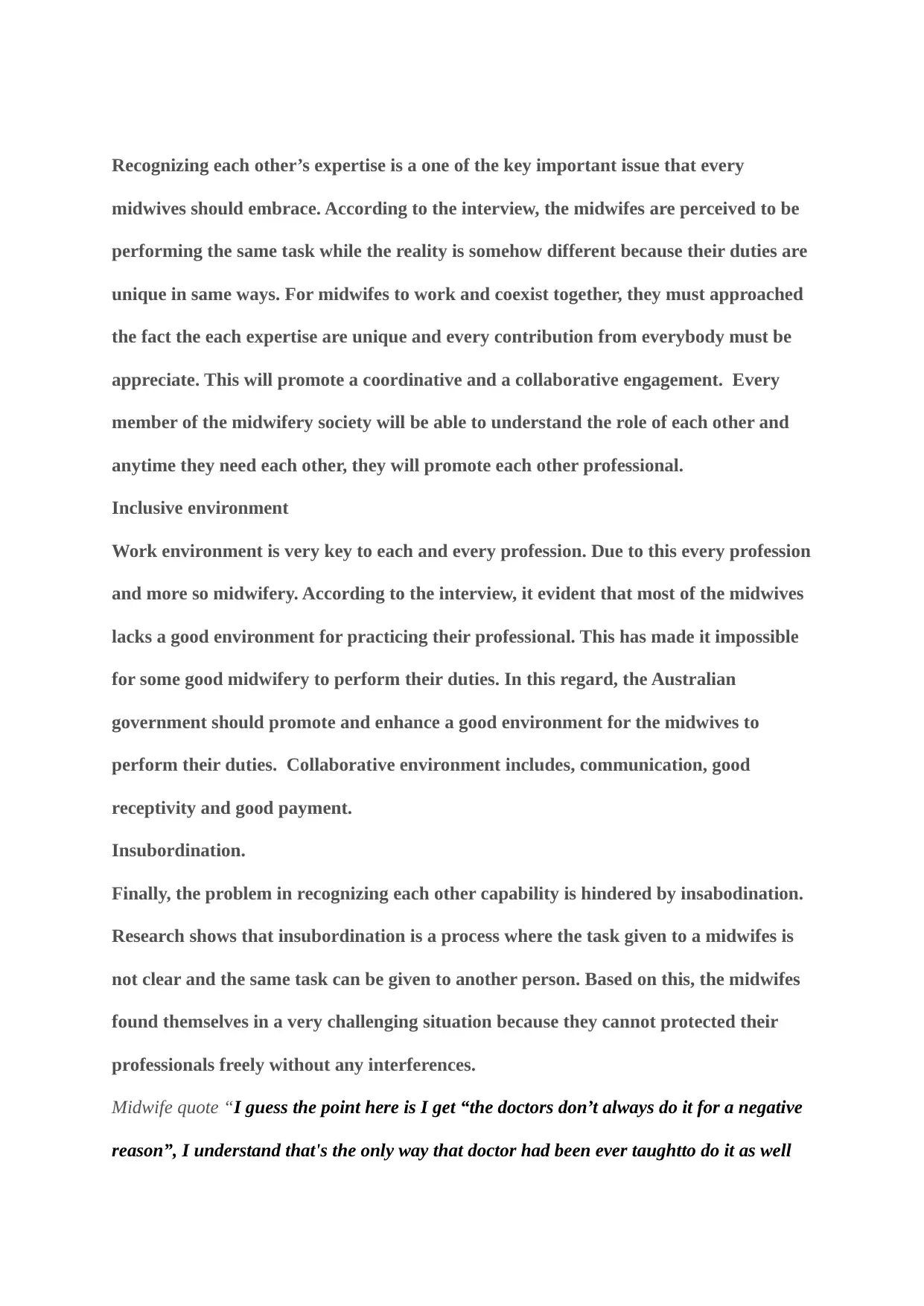
Recognizing each other’s expertise is a one of the key important issue that every
midwives should embrace. According to the interview, the midwifes are perceived to be
performing the same task while the reality is somehow different because their duties are
unique in same ways. For midwifes to work and coexist together, they must approached
the fact the each expertise are unique and every contribution from everybody must be
appreciate. This will promote a coordinative and a collaborative engagement. Every
member of the midwifery society will be able to understand the role of each other and
anytime they need each other, they will promote each other professional.
Inclusive environment
Work environment is very key to each and every profession. Due to this every profession
and more so midwifery. According to the interview, it evident that most of the midwives
lacks a good environment for practicing their professional. This has made it impossible
for some good midwifery to perform their duties. In this regard, the Australian
government should promote and enhance a good environment for the midwives to
perform their duties. Collaborative environment includes, communication, good
receptivity and good payment.
Insubordination.
Finally, the problem in recognizing each other capability is hindered by insabodination.
Research shows that insubordination is a process where the task given to a midwifes is
not clear and the same task can be given to another person. Based on this, the midwifes
found themselves in a very challenging situation because they cannot protected their
professionals freely without any interferences.
Midwife quote “I guess the point here is I get “the doctors don’t always do it for a negative
reason”, I understand that's the only way that doctor had been ever taughtto do it as well
midwives should embrace. According to the interview, the midwifes are perceived to be
performing the same task while the reality is somehow different because their duties are
unique in same ways. For midwifes to work and coexist together, they must approached
the fact the each expertise are unique and every contribution from everybody must be
appreciate. This will promote a coordinative and a collaborative engagement. Every
member of the midwifery society will be able to understand the role of each other and
anytime they need each other, they will promote each other professional.
Inclusive environment
Work environment is very key to each and every profession. Due to this every profession
and more so midwifery. According to the interview, it evident that most of the midwives
lacks a good environment for practicing their professional. This has made it impossible
for some good midwifery to perform their duties. In this regard, the Australian
government should promote and enhance a good environment for the midwives to
perform their duties. Collaborative environment includes, communication, good
receptivity and good payment.
Insubordination.
Finally, the problem in recognizing each other capability is hindered by insabodination.
Research shows that insubordination is a process where the task given to a midwifes is
not clear and the same task can be given to another person. Based on this, the midwifes
found themselves in a very challenging situation because they cannot protected their
professionals freely without any interferences.
Midwife quote “I guess the point here is I get “the doctors don’t always do it for a negative
reason”, I understand that's the only way that doctor had been ever taughtto do it as well
Paraphrase This Document
Need a fresh take? Get an instant paraphrase of this document with our AI Paraphraser
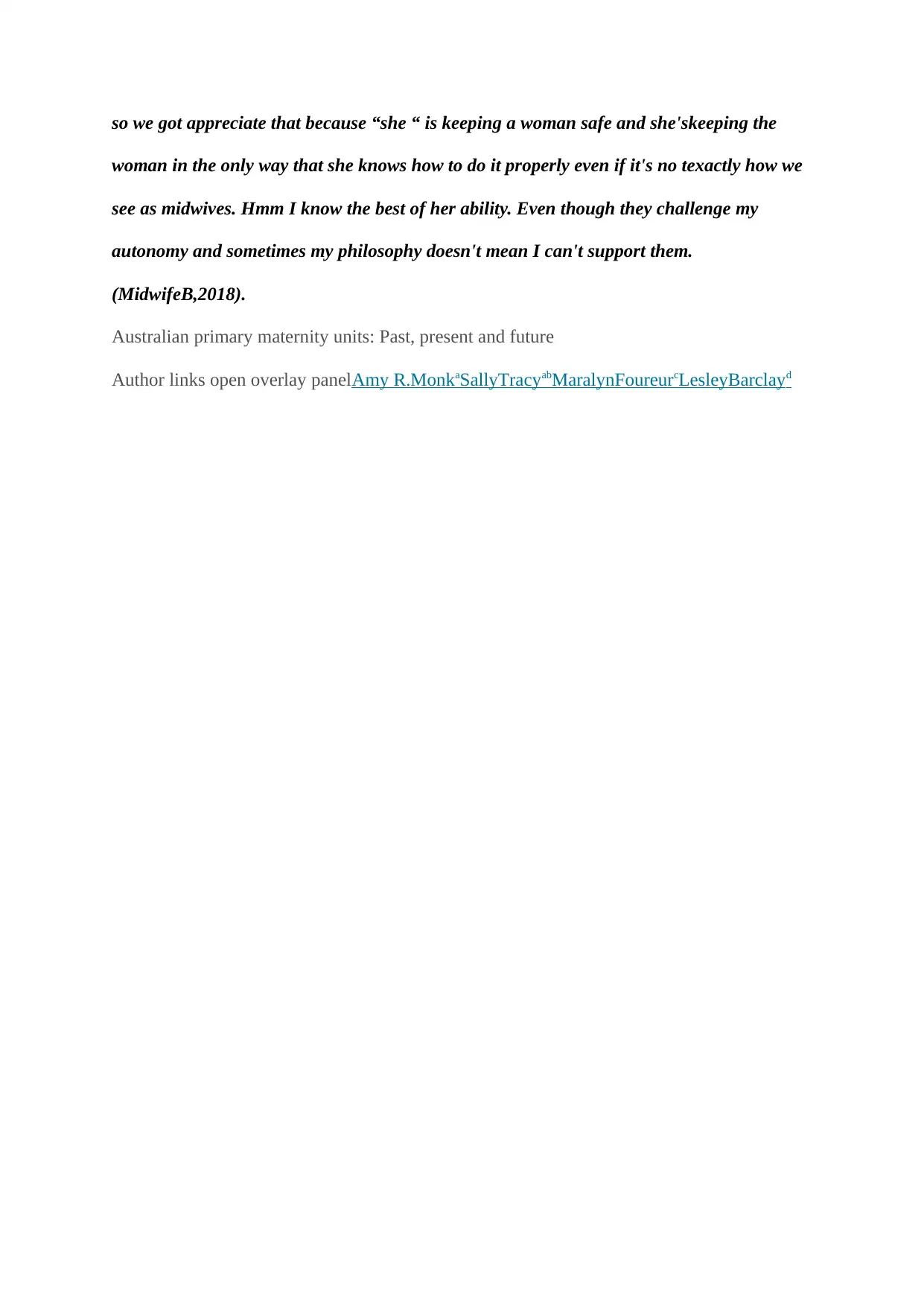
so we got appreciate that because “she “ is keeping a woman safe and she'skeeping the
woman in the only way that she knows how to do it properly even if it's no texactly how we
see as midwives. Hmm I know the best of her ability. Even though they challenge my
autonomy and sometimes my philosophy doesn't mean I can't support them.
(MidwifeB,2018).
Australian primary maternity units: Past, present and future
Author links open overlay panelAmy R.MonkaSallyTracyabMaralynFoureurcLesleyBarclayd
woman in the only way that she knows how to do it properly even if it's no texactly how we
see as midwives. Hmm I know the best of her ability. Even though they challenge my
autonomy and sometimes my philosophy doesn't mean I can't support them.
(MidwifeB,2018).
Australian primary maternity units: Past, present and future
Author links open overlay panelAmy R.MonkaSallyTracyabMaralynFoureurcLesleyBarclayd
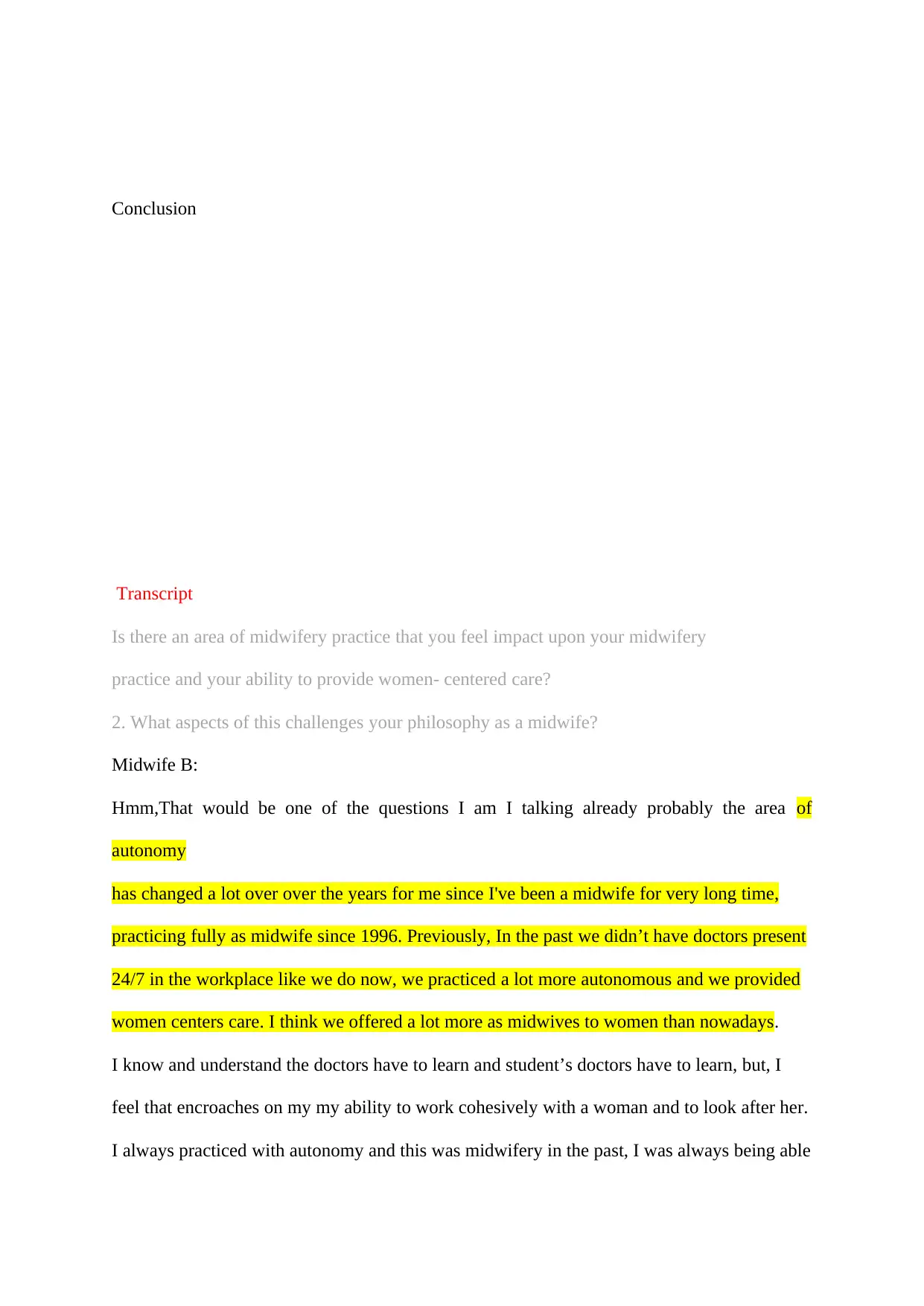
Conclusion
Transcript
Is there an area of midwifery practice that you feel impact upon your midwifery
practice and your ability to provide women- centered care?
2. What aspects of this challenges your philosophy as a midwife?
Midwife B:
Hmm,That would be one of the questions I am I talking already probably the area of
autonomy
has changed a lot over over the years for me since I've been a midwife for very long time,
practicing fully as midwife since 1996. Previously, In the past we didn’t have doctors present
24/7 in the workplace like we do now, we practiced a lot more autonomous and we provided
women centers care. I think we offered a lot more as midwives to women than nowadays.
I know and understand the doctors have to learn and student’s doctors have to learn, but, I
feel that encroaches on my my ability to work cohesively with a woman and to look after her.
I always practiced with autonomy and this was midwifery in the past, I was always being able
Transcript
Is there an area of midwifery practice that you feel impact upon your midwifery
practice and your ability to provide women- centered care?
2. What aspects of this challenges your philosophy as a midwife?
Midwife B:
Hmm,That would be one of the questions I am I talking already probably the area of
autonomy
has changed a lot over over the years for me since I've been a midwife for very long time,
practicing fully as midwife since 1996. Previously, In the past we didn’t have doctors present
24/7 in the workplace like we do now, we practiced a lot more autonomous and we provided
women centers care. I think we offered a lot more as midwives to women than nowadays.
I know and understand the doctors have to learn and student’s doctors have to learn, but, I
feel that encroaches on my my ability to work cohesively with a woman and to look after her.
I always practiced with autonomy and this was midwifery in the past, I was always being able
⊘ This is a preview!⊘
Do you want full access?
Subscribe today to unlock all pages.

Trusted by 1+ million students worldwide
1 out of 17
Related Documents
Your All-in-One AI-Powered Toolkit for Academic Success.
+13062052269
info@desklib.com
Available 24*7 on WhatsApp / Email
![[object Object]](/_next/static/media/star-bottom.7253800d.svg)
Unlock your academic potential
Copyright © 2020–2025 A2Z Services. All Rights Reserved. Developed and managed by ZUCOL.




